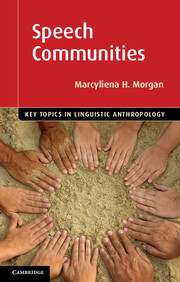Book contents
- Frontmatter
- Contents
- Acknowledgments
- Transcription Conventions
- 1 What are speech communities?
- 2 Representing speech communities
- 3 Constructing speech communities
- 4 The African American speech community
- 5 Youth communities: the Hiphop Nation
- 6 Voice and empowerment in gender and sexuality
- 7 Online speech communities
- 8 Language in and out of the classroom
- 9 Performance and play in speech communities
- 10 Power, ideology and prejudice
- Bibliography
- Index
- References
3 - Constructing speech communities
Published online by Cambridge University Press: 05 June 2014
- Frontmatter
- Contents
- Acknowledgments
- Transcription Conventions
- 1 What are speech communities?
- 2 Representing speech communities
- 3 Constructing speech communities
- 4 The African American speech community
- 5 Youth communities: the Hiphop Nation
- 6 Voice and empowerment in gender and sexuality
- 7 Online speech communities
- 8 Language in and out of the classroom
- 9 Performance and play in speech communities
- 10 Power, ideology and prejudice
- Bibliography
- Index
- References
Summary
This chapter introduces some of the language and discourse styles and social factors that help define and identify specific speech communities. As we have seen in previous chapters, there are numerous activities and interactions within and between members of speech communities that can be ongoing and involve multiple participants. There are also numerous speech events and verbal genres that are framed and sequenced and determined by role and status of participants, norms of interactions, expectation of content, etc. At issue here is not only how people form speech communities and learn how to function competently as members, but also where they form their communities.
Participating in speech communities requires “learning how to mean” (cf. Halliday 1978) according to norms and details of language, discourse and ideology, and rules and goals of engagement. As discussed in Chapter 2, when speech communities are viewed as having physical boundaries, there may be disputes and claims to public spaces and places that signify power and full membership in society. There may also be claims to spaces that are imagined (cf. Anderson 1983), such as online communities that are constructed around and include many of the same social issues found in the physical world. In either case we understand that speech communities exist through participation and as a result of socialization about how to be a member of a social group. In order to participate fully one must develop “communicative competence” in the use of conventions, practices and ideologies of specific speech communities in order to navigate the social world and all its complexities.
- Type
- Chapter
- Information
- Speech Communities , pp. 36 - 49Publisher: Cambridge University PressPrint publication year: 2014

